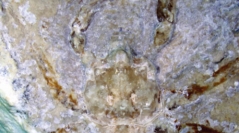

 Geodiversitas
41 (7) - Pages 285-322
Geodiversitas
41 (7) - Pages 285-322A small brachyuran crab, Archaeochiapasa mardoqueoi n. gen., n. sp., is reported from the lower Cenomanian (Upper Cretaceous) of the Sierra Madre Formation at El Chango Lagerstätte, Chiapas State, southeastern Mexico. Although it is decorticated and only the counterpart keeps a large part of the cuticle, the single male specimen exhibits an exceptional three-dimensional preservation that allows its description to be based not only on the dorsal carapace, both chelipeds and most walking legs, but also on remarkably conserved ventral structures: mxp3, thoracic sternum, and pleon. Archaeochiapasa mardoqueoi n. gen., n. sp. provides a morphological combination that does not conform to any previously known fossil brachyuran and furthermore to any extant family. The high number of major differential characters suggest that Archaeochiapasa n. gen. must be included in the Eubrachyura Saint Laurent, 1980. A series of apomorphies supports the erection of a new family for which we introduce the new name Archaeochiapasidae n. fam. This fortunate discovery allows us to identify one of the earliest eubrachyurans with unique features, namely a very wide thoracic sternum displaying an unexpected structure for a lower Cenomanian representative, and a depressed, rimmed area (‘flange’) along the carapace postero- and postero-lateral margin. The new family is compared to the other fossil Eubrachyura known from the Early and mid-Cretaceous, which are very scarce and often incomplete, and to the more basal heterotreme Recent clades that are presently recognised on the basis of morphological, larval, spermatozoal and genetic data, e.g. the Dorippoidea MacLeay, 1838, and to the basal families of Majoidea Samouelle, 1819 (Oregoniidae Garth, 1958, Inachoididae Dana, 1851, and Inachidae MacLeay, 1838). A challenging hypothesis based on new interpretations is that the Late Jurassic Lecythocaridae Schweitzer & Feldmann, 2009 (in Glaessneropsoidea Patrulius, 1959), only known by dorsal carapaces and formerly included in the Dromiacea De Haan, 1833, could be related, with still obscure relationships, to the same lineage as the Archaeochiapasidae n. fam. The two families actually show striking similarities, such as the overall morphology of carapace, a depressed area along the carapace posterior margin, and a bifurcate short rostrum. Therefore, we assume that, despite their Jurassic age, Lecythocaridae may well also be Eubrachyura, which brings the first “true crabs” or eubrachyurans (i.e., non-podotreme crabs) back to the Jurassic, contrary to the current opinions of paleontologists. The discovery of Archaeochiapasidae n. fam. raises a crucial question: the development of a very wide thoracic sternum in this old eubrachyuran. Is it the expression of an ancestral dispostion (plesiomorphy) or the result of an already existing evolutionary process of carcinisation (apomorphy)? And what is its phylogenetic significance?
Cretaceous, lower Cenomanian, Jurassic, El Chango quarry, Dorippoidea, Majoidea, Oregoniidae, Inachoididae, Inachidae, Hymenosomatoidea, exceptional preservation, new family, new genus, new species